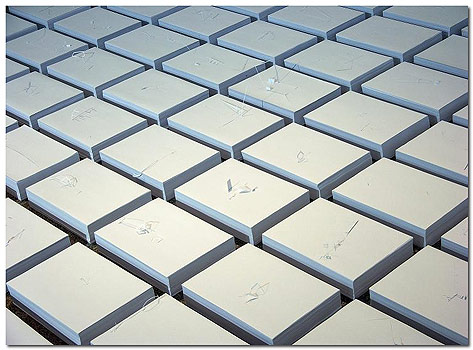Kemper Museum of Contemporary Art,
Apr 13, 2001 - Jul 08, 2001
Kansas City, Missouri, USA
Curatorial Essay
by Dana Self
We are condemned to know more and understand less; it's not a contradictory process, it's a semiotic indigestion. - Marco Maggi.(1) Marco Maggi's diminutive works encode the world - a big idea - in a visual gesture mimicking the complex technology that grants us instant communication. Small, etched, shriveled apples (McIntoshes, of course) and delicately precise drawings are two conveyances of his intimate and myriad meditations on how we communicate with one another. He tenders his semiotics - signs suggesting other meanings - in a mystical shorthand, yet through his fastidious attention to process and minute detail, he grounds his work in something we may understand after all: our bodily relationship to his small works. To really see the work, we must physically be so close to it that we breathe on it - just what Maggi is after. Maggi's drawings - or etchings and engravings as he often describes them - on paper, aluminum foil, clay, and apples are renderings of nothing wholly recognizable. The drawings are composed mostly of a variety of linear patterns and nonpatterns that suggest a circuit board, the map of an ancient city from an archaeological dig, or the grid of a modern city as imaged from a distant point in space. These elusive images are anchored by earthbound enterprises such as mapping and engineering. What to make of Maggi's mapping impulse? The catalyst to map has a broad history. In the 17th century, for instance, the Dutch, fascinated by their expanding dominion, part of which they reclaimed from the sea, created extensive maps of their shifting territory, which artists such as Jan Vermeer imaged within his paintings. The invention of scientific tools such as the lens and microscope underwrote this eagerness to visualize the world. Cartographers, scientists, and visual artists zealously strived to make the world visible through an expressible optical gesture: a map, a topographical or biological drawing, a painting. Maggi also conspires to make new territory or the as-yet-to-be-understood visible; but his drawings only suggest - they don't explain - the encoded and encrypted technologies through which we communicate. He often comments on the high-volume, technology-driven speed of the world in which he lives, and how his art is a visual response to that overstimulation. Paradoxically yet not coincidentally, he and I worked out the details of his exhibition solely through electronic communication. The fact that we - artist and curator with congruent desires and goals - never met face to face prior to the installation amplifies the works' meaning. Maggi must use the very technology he seeks to excavate for critical inquiry, in order to complete his working processes: in this instance, having a museum exhibition. By working in such tiny formats (some of his drawings are the size of 35mm slides) and with complex imagery (our attempts to figure out the grids of his drawings or follow a line to its visually logical conclusion are usually thwarted), he obliges the viewer to reduce her pace, if only for this particular moment of looking. Maggi's lyrical mapping, however nonspecific and nonscientific, is an attempt to engineer our experience, to mediate between us and the larger world of signs and systems - those semiotics that Maggi suggests give us "indigestion," such as television, electronics, film, computers, cell phones, and the like. He notes, "Our world is full of signs that we cannot understand: new circuits, old alphabets, atoms, dolmens, cells, biologic or urban fabrics, encrypted messages, mutant viruses,"(2) all of which, according to Maggi, run interference to liberating our minds of unnecessary information. Problem is, like all information absorbed, we can't unknow what we know. Like enduring catastrophe or knowing profound grief, that experience, that grief can never be unknown, hard as we might try. But then, neither can beauty. And Maggi's drawings, b
|








